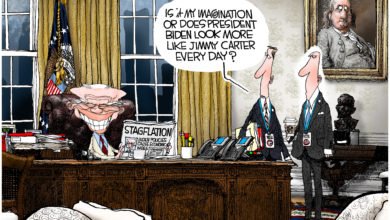Why ‘Economics in One Lesson’ Is as Readable Today as It Was in 1946
One of the first economics books I ever read was Economics in One Lesson by Henry Hazlitt and I could hardly have asked for a better introduction to the science of human action. Generations later, no update needs to be written, it is just as timely and just as applicable in the 21th century as it was in the last.
Originally published in 1946, Hazlitt wrote in a different world. The Second World War was a year in the history books and the armies were demobilizing, to the horror of the New Dealers who treated the military as a massive employment program. Socialism was defeated in Germany, but the US accomplished this by adopting some of the same tyrannical controls her enemies did.
Liberty, though loudly proclaimed as a slogan, was an unpopular ideal.
Even though the “Sophisms” of many contemporary economists denigrated liberty, Hazlitt went against the stream by writing a book with the express purpose of knocking down the most persistent and pernicious fallacies in the field. He had the foresight to avoid making very particular arguments with the statistics, headlines, and quotations of the day, which may have disappointed readers decades ago, but is to the benefit of readers today. By not being bogged down with verbatims and numbers, he crafted flowing arguments which rebut the wider form of falsehood as opposed to specific instances. Did Hercules defeat the Hydra by attacking each head as it regenerated (specific economic falsehoods), or by attacking their source (generalized falsehoods)?
His premise was that economics contains everything needed to obliterate the generalized falsehoods, and from there all the specified ones: “The art of economics consists in looking not merely at the immediate, but at the longer effects of any act or policy; it consists in tracing the consequences of that policy, not merely for one group, but for all groups.”
This is the lesson, no more and no less.
Simplicity was the name of the game with Economics in One Lesson. Although he explicitly named Ludwig von Mises as an inspiration, Hazlitt was not creating a treatise like Human Action. That being said, one would err by saying the “one lesson” was incomplete; indeed the book says all that needs to be said.
The present is yesterday’s tomorrow, or in other words, the day that bad economists gone before told their contemporaries not to worry. Keynes famously quipped, “In the long run, we’re all dead,” and this attitude of disregarding long-term consequences in favor of results today has helped breed poor policy and the economics of the present. In concert with the time frame fallacy, there is also the group benefit, one which looks only at one “group” and how a policy affects them, while ignoring all others. What looks good for X may be detrimental to Y and if only the former is examined, the policy will be thought universally beneficial because the group under the microscope excelled, even if the group just beyond the lens was sacrificed.
These interconnected fallacies come in a variety of species. Hazlitt enumerated over twenty of them and methodically applied the lesson to them. These included, but were not limited to: Protectionism, disbanding the WWII army, and public works.
With protectionism and tariff mongering, the state, in collusion with politically connected corporations, levies duties on imports in order to keep American producers from being undersold by their foreign counterparts. The myth that this is economically beneficial became especially topical when former-president Trump resurrected the tariff as a political issue from the depths of the 19th century. On one occasion he tweeted: “Billions of Dollars are pouring into the coffers of the U.S.A. because of the Tariffs being charged to China, and there is a long way to go. If companies don’t want to pay Tariffs, build in the U.S.A. Otherwise, lets (sic) just make our Country richer than ever before!”
Hazlitt made short work of this myth by pointing out that tariffs only protect the inefficient businesses that cannot stay afloat in a competitive market. Say Britain can produce sweaters cheaper than the US and the tariff is repealed. The protectionists are right, Hazlitt says, in that the US sweater industry will lose jobs; but the customers who formerly bought from them will get an equal or better product cheaper and with the money they saved they will buy from other firms.
This saved money grows another, more efficient industry in America and the jobs lost in the sweater industry are compensated for by gains here. By failing to see the consequences for the consumer and the more efficient industry and only looking at the sweater industry, the protectionists mislead and advance shadowy, narrow, corporate interests over the general interest.
When it came to demobilizing the war machine that defeated Hitler, Mussolini, and Tojo, Hazlitt writes of the hand-wringing by the professional class in Washington over what would come of it. After all, where will the money come from to employ all of these new prospective workers? Instead of disaster, Hazlitt showed, there was a boon.
With the war over, the US could cut back on government spending for the military and cut taxes across the board. Lower taxes mean more investment and more personal consumption, which leads to massive job growth. Like magic, the demobilized army and fleet provide all the labor needed to staff offices and factories. Once the new workers are employed, the gains from trade created by exchanging labor for remuneration generate more wealth. Since the old warfighters not only are no longer supported by the taxpayers, but also produce gains from trade through employment in the private sector, there could scarcely have been anything better than demobilizing the WWII military force once it had served its purpose.
Look also at the public works meant to provide employment rather than produce something essential, like an army depot. Hazlitt conjures up a bridge; its construction will cost $1,000,000 and put 500 men to work for a year. The jobs created and the new bridge are all the statist economists want to see, they ignore that the cost is funded out of taxes and the money used to pay those would have gone elsewhere, stimulating employment in some other place than the bridge construction site. The bridge did not create a net gain of jobs at all: “Therefore for every public job created by the bridge project a private job has been destroyed somewhere else.”
These are but three examples of the lesson applied, and more could of course be added beyond what Hazlitt wrote in his book; it is hardly possible to write a complete taxonomy of economic folly (let alone a hypothetical one).
In each case, regardless of its particulars, the costs of disregarding the long-term and other groups are the downfall of statist schemes. The wisdom in Economics in One Lesson is still valid generations later, and to prove it, the book is still in print and an author can hardly look for a better legacy for his work.
Content syndicated from Fee.org (FEE) under Creative Commons license.
Agree/Disagree with the author(s)? Let them know in the comments below and be heard by 10’s of thousands of CDN readers each day!




